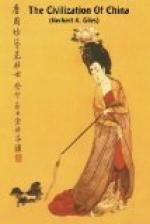The long-lived and glorious House of Han was brought to a close by the usual causes. There were palace intrigues and a temporary usurpation of the throne, eunuchs of course being in the thick of the mischief; added to which a very serious rebellion broke out, almost as a natural consequence. First and last there arose three aspirants to the Imperial yellow, which takes the place of purple in ancient Rome; the result being that, after some years of hard fighting, China was divided into three parts, each ruled by one of the three rivals. The period is known in history as that of the Three Kingdoms, and lasted from A.D. 220 to A.D. 265. This short space of time was filled, especially the early years, with stirring deeds of heroism and marvellous strategical operations, fortune favouring first one of the three commanders and then another. The whole story of these civil wars is most graphically told in a famous historical romance composed about a thousand years afterwards. As in the case of the Waverley novels, a considerable amount of fiction has been interwoven with truth to make the narrative more palatable to the general reader; but its basis is history, and the work is universally regarded among the Chinese themselves as one of the most valuable productions in the lighter branches of their literature.
The three to four centuries which follow on the above period were a time of political and social disorganisation, unfavourable, according to Chinese writers, to the development of both literature and art. The House of Chin, which at first held sway over a once more united empire, was severely harassed by the Tartars on the north, who were in turn overwhelmed by the House of Toba. The latter ruled for some two hundred years over northern China, while the southern portions were governed by several short-lived native dynasties. A few points in connexion with these times deserve perhaps brief mention.
The old rule of twenty-seven months of mourning for parents was re-established, and has continued in force down to the present day. The Japanese sent occasional missions, with tribute; and the Chinese, who had already in A.D. 240 dispatched an envoy to Japan, repeated the compliment in 608. An attempt was made to conquer Korea, and envoys were sent to countries as far off as Siam. Buddhism, which had been introduced many centuries previously—no one can exactly say when—began to spread far and wide, and appeared to be firmly established. In A.D. 399 a Buddhist priest, named Fa Hsien, started from Central China and travelled to India across the great desert and over the Hindu Kush, subsequently visiting Patna, Benares, Buddha-Gaya, and other well-known spots, which he accurately described in the record of his journey published on his return and still in existence. His object was to obtain copies of the sacred books, relics and images, illustrative of the faith; and these he safely conveyed to China by sea from India, via Ceylon (where he spent three years), and Sumatra, arriving after an absence of fifteen years.




